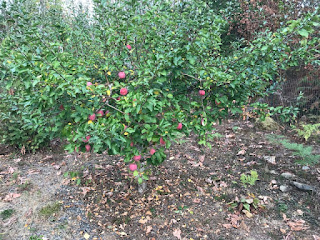As I mentioned last week, John and I have slacked off on proper orchard care the last few years.
Lots of bushy growth from late pruning
I’m not sure how it happened—sure, the weather didn’t always cooperate, and there were the usual family commitments, chicken care, or a million other chores that took precedence. But the fact remains, our apple trees were neglected.
We’d gotten behindhand in
two basic ways: pruning and thinning.
Pruning is essential.
Apple trees in our climate grow an insane amount each year; lots of our trees
grow five or six feet each, with lots of bushy interior growth. Yearly pruning
helps open up the middle of the tree—much easier when it comes to picking, for
sure!
Pruning ideally should
take place during the dormant season, when the tree hasn’t yet started its
spring growth—in our area, February is recommended.
The problem is, we’ve
gotten a fair number of northeasters in February, making it a challenge for
even the hardiest of gardeners to get into the orchard!
But we can’t use wintry
weather as an excuse. John and I have often not gotten around to pruning until as
late as April. Or even May. And one spring, I think it was three years ago, we
didn’t prune at all. The trees turned into monsters! And were that much harder
to manage the following year.
Anyway, when you prune a
tree in mid- to late spring, it only encourages the tree to grow even more. And
you wind up with a bushy tree that is putting its energy into producing leaves,
not high-quality fruit.
Pruning, as it happens,
works in concert with thinning. A bigger
tree produces more blossoms, which in turn means more potential fruit. A
smaller, neatly trimmed tree will naturally have less fruit set.
But you’ll still need to
thin. Without it, you’ll generally wind up with a tree that will overbear one
year, and the next, produce little or no fruit at all.
Thinning also will help
you have larger, healthier fruit, instead of the smaller, even stunted fruit that
you’ll often find on an overbearing tree. John and I have also erred in
thinning way too late, in mid-summer instead of early June, when the tree has already put oodles of energy into hundreds of apples, instead of dozens.
The rule of thumb: thin
your apples to keep about 5 inches between fruits. Apple trees will often set
fruit in multiple clusters of three, four, five or even more apples per fruit
spur. So make sure to select the most vigorous little fruit in the cluster, and
remove the others.
Given this neglect, John
and I have often wound up with overgrown, overbearing trees. Which has led me
to suspect it may have something to do with our apple maggot problem. It seems
to me that with less fruit to attract the maggot flies, Berryridge Farm won’t
be such a target-rich environment.
As an aside, the same
goes for the neighborhood bears! Without so much fruit at our place, maybe they’ll
be less tempted to break down the fences and go on an eating binge.
Back to apple maggot: the photo below was taken the first year we found the damage. At the time, I thought it was terrible! Come to find out, these bits of brown were minor--many of our apples will now have brown tracks and some mushiness all the way through the interior.
One chore you can do to help this fall: go through your orchard and pick up all the little fruits any tree dropped over the summer. That means less food for the maggot larvae that are living on the ground below the tree.
Years
ago, I read about protecting your apples from this pest by diligently enclosing
each and every apple in a Ziploc bag. At the time, I sorta cringed. All that
plastic! All that time!
But as much as I don’t
want to go the plastic route, I’m ready. It’ll certainly save money on buying nematodes.
And maybe we’ll be able to reuse the bags.
To sum up, for our nine
apple trees, here’s our plan for 2023:
1st: We’ll
prune in February, as orchardists recommend, to maintain smaller, less bushy
trees.
2nd : We’re
going to take a pass on nematodes this fall. It’s been too dry to apply them,
and soon it’ll be too cold. We’ll apply them only in spring and see how it
goes.
3rd : We’ll
thin the fruit early—when the fruits are the diameter of a quarter—to give the
tree a chance to put its energy into producing larger fruits, in smaller numbers.
Then we’ll bite the
bullet and get out the Ziplocs!

No comments:
Post a Comment